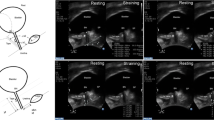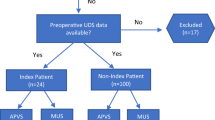Abstract
The purpose of this study is to evaluate the ability of preoperative urodynamic urethral function parameters to predict the success rate of transobturator slings (TOS). Seventy women urodynamically diagnosed with stress incontinence with urethral hypermobility underwent a Monarc™ TOS (American Medical Systems, Minnetonka, USA). Postoperative continence status was correlated with preoperative urodynamic urethral function parameters. Mathematical modeling was used to determine whether urodynamic parameters can be used to predict postoperative continence. Average follow-up was 8.1 (6–12) months; 56 (80%) patients were continent based on a standardized stress test and subjective report. The median Valsalva leak point pressure at 150 cc (VLPP150) in the failures and successes was not different (p = 0.12). The median VLPP at cystometric capacity (VLPPcap) in the failures was 32 cmH2O compared to 71 cmH2O in the successes (p < 0.001). The maximum urethral closure pressure (MUCP) had a median of 20 cmH2O in the failures and 45 cmH2O in the successful patients (p < 0.001). No correlation existed between the degree of urethral hypermobility, as measured by the cotton swab test, and surgical success (p = 0.17). There was no correlation between level of preoperative urethral function and persistent overactive bladder symptoms, post-void residual, voids/day, and nocturia. Using a combined model, the cutoff values of VLPPcap > 60 cmH2O and MUCP > 40 cmH2O were the most predictive of surgical success, revealing a sensitivity of 83% (0.55, 0.95) and specificity of 79% (0.67, 0.88). A combination of urodynamic parameters can be used to predict continence rates after a TOS. A TOS should be used with caution in women with impaired urethral function.


Similar content being viewed by others
References
Ulmsten U, Henriksson L, Johnson P, Varhos G (1996) An ambulatory surgical procedure under local anesthesia for treatment of female urinary incontinence. Int Urogynecol J 7:81–86
Nilsson CG, Kuuva N, Falconer C et al (2001) Long-term results of the tension-free vaginal tape (TVT) procedure for surgical treatment of female stress urinary incontinence. Int Urogynecol J (Suppl 2):S5–S8
Pelosi MA II, Pelosi MA III (2003) New transobturator sling reduces risk of injury. OBG Manage 15(7):17–38
Peyrat L, Boutin JM, Bruyere F et al (2001) Intestinal perforation is a complication of TVT procedure for UI. Eur Urol 39:603–605
Walters MD, Tulikangas PR, LaSala C et al (2001) Vascular injury during tension-free vaginal tape procedure for stress urinary incontinence. Obstet Gynecol 98:957–959
Zilbert AW, Farrell SA (2001) External iliac artery laceration during tension-free vaginal tape procedure. Int Urogynecol J 12:141–143
Vierhout ME (2000) Severe hemorrhage complicating TVT: a case report. Int Urogynecol J 12:139–140
Brink DM (2000) Bowel injury following insertion of TVT. S Afr Med J 90:450–452
Shobeiri SA, Garely AD, Chesson RR (2002) Recognition of occult bladder injury during the tension-free vaginal tape procedure. Obstet Gynecol 99:1067–1072
Wang KH, Neimark M, Davila GW (2002) Voiding dysfunction following TVT procedure. Int Urogynecol J 13(6):353–357
Delorme E (2001) Transobturator urethral suspension: mini-invasive procedure in the treatment of urinary stress incontinence in women. Prog Urol 11(6):1306–1313
Boyles SH, Edwards R, Gregory W, Clark A (2007) Complications associated with trans-obturator sling procedures. Int Urogynecol J 18(1):19–22
de Tayrac R, Deffieux X, Droupy S, Chauveaud-Lambling A, Calvanese-Benamour L, Fernandez H (2004) A prospective randomized trial comparing tension-free vaginal tape and transobturator suburethral tape for surgical treatment of stress urinary incontinence. Am J Obstet Gynecol 190(3):602–608, (retracted)
Sand PK, Bowen LW, Panganiban R, Ostergard DR (1987) The low pressure urethra as a factor in failed retropubic urethropexy. Obstet Gynecol 69(3):399–402
Rezapour M, Falconer C, Ulmsten U (2001) Tension-free vaginal tape (TVT) in stress incontinent women with intrinsic sphincter deficiency (ISD)—a long-term follow-up. Int Urogynecol J 12(Suppl):S12–S14
Raders JL, Aguirre O, Davila GW (2004) Polypropylene patch sling for the treatment of intrinsic sphincter deficiency. J Pelvic Med Surg 10(Suppl):S63
Haab F, Trockman BA, Zimmern PE, Leach GE (1997) Results of pubovaginal sling for the treatment of intrinsic sphincter deficiency determined by questionnaire analysis. J Urol 158:1738–1741
Author information
Authors and Affiliations
Corresponding author
Additional information
G. Willy Davila is a consultant to American Medical Systems.
Rights and permissions
About this article
Cite this article
Guerette, N.L., Bena, J.F. & Davila, G.W. Transobturator slings for stress incontinence: using urodynamic parameters to predict outcomes. Int Urogynecol J 19, 97–102 (2008). https://doi.org/10.1007/s00192-007-0393-x
Received:
Accepted:
Published:
Issue Date:
DOI: https://doi.org/10.1007/s00192-007-0393-x




